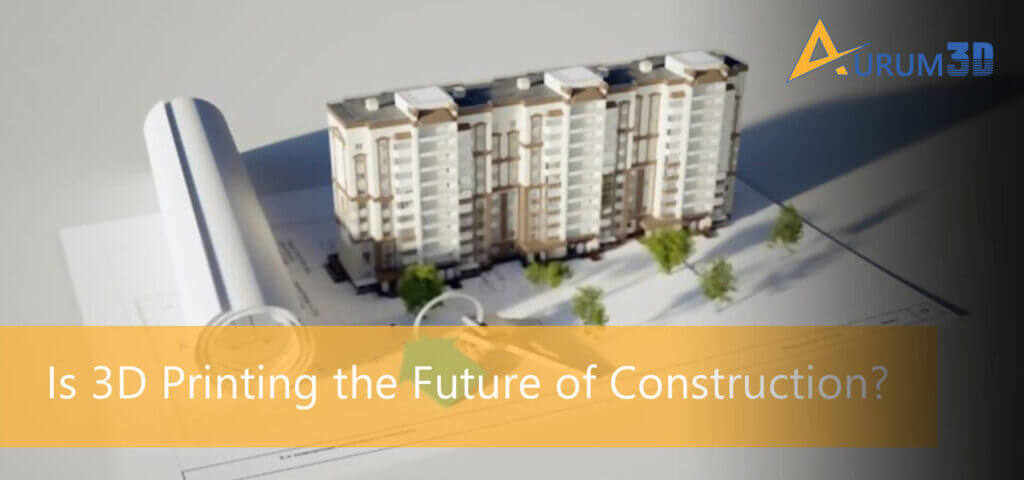In addition to driving the Fourth Industrial Revolution or Industry 4.0, 3D printing technologies have been transforming a matrix of conventional industries, including construction. The rapid growth of the worldwide 3D printing construction market depicts the transformative impact of 3D printing on the future of construction.
According to a market analysis report published by Grand View Research,
“The global 3D printing construction market size was valued at USD 11,268.9 thousand in 2021 and is projected to register a compound annual growth rate (CAGR) of 100.7% from 2022 to 2030. The increasing use of 3D printing in the construction industry is driving the market growth.”
Construction companies these days have the option to choose from a wide range of construction 3D printers. Each construction 3D printer builds structures by depositing materials layers by layer. An engineer can use the appropriate construction 3D printing technology to construct building structures using the desired material – concrete, metal, or polymer.
In addition to supporting multiple materials, construction 3D printers help builders reduce the time and resources required to construct complex building structures. They further help engineers design innovative structures with a higher level of accuracy and efficiency. Many engineers and architects already leverage the benefits of 3D printing to create affordable and eco-friendly housing solutions.
Also, they have been driving the growth of the construction 3D printing market by creating new use cases regularly. Also, they explore ways to fix various issues and overcome many barriers affecting the growth of the worldwide construction 3D printing market. We can assess the transformative impact of 3D printing on the future of construction based on such use cases.
Understanding the Huge Impact of 3D Printing on the Future of Construction
Facilitating Faster and Accurate Construction
Design freedom is often cited as a key advantage of 3D printing technologies. 3D printers produce solid three-dimensional structures from digital 3D models. Engineers and architects can use 3D modeling software to build complex designs without putting in extra time and resources.
Also, 3D printing technologies create opportunities for them to design innovative and unique structures by unleashing their creativity and expertise. At the same time, architects can use construction 3D printers to convert these virtual designs into solid structures without increasing construction time.
Eliminating Human Errors
Traditional construction methods are vulnerable to a variety of human errors. Human errors cause fatal construction injuries and increase construction worker deaths regularly. Construction companies often find it challenging to prevent injuries and worker deaths despite implementing many safety measures.
3D printing technologies have the potential to eliminate worker injuries and fatalities in the construction industry through automated and programmable construction processes. Also, engineers can produce programmable housing solutions with minimal human effort. However, we must not forget that errors in the digital model will directly impact the accuracy and quality of the 3D-printed housing solutions.
Meeting Surge in Home Sales Activities
A study conducted by Freddie Mac suggests that approximately four million new homes need to be constructed in the USA to meet the market demand after the COVID-19 pandemic. Construction companies cannot meet the surge in market demand using traditional construction methods.
That is why; construction companies have been adopting next-generation technologies like 3D printing and cloud computing to meet the surge in home sales activities. Construction 3D printing will continue to drive home sales activities by reducing overall construction time and costs significantly.
Creating Affordable Housing Solutions
After the COVID-19 pandemic, the demand for affordable housing will rise steadily. But the inflationary phase of the global economy has been escalating building material and labor cost consistently. Hence, construction companies cannot create and deliver affordable housing solutions without modernizing construction.
In addition to modernizing construction, 3D printing technologies help companies curtail constructions cost by reducing building material consumption and wastage. Also, they reduce labor costs significantly through automation. The construction of affordable houses will remain one of the most significant impacts of 3D printing on the future of construction.
Eliminating the Need for Additional Tooling
The COVID-19 lockdowns and shutdowns made it difficult for construction companies to get new materials, relevant support, and additional tooling by disrupting supply chains. Many architects leverage construction 3D printing technologies to eliminate the need to procure additional tooling.
They continued construction projects by switching from conventional construction methods to pre-programmers structures. Engineers and architects will use 3D printing technologies in the future to eliminate additional tooling to simplify construction and reduce construction costs.
Accelerating Disaster Recovery
No owner can repair or restore his home damaged by natural disasters quickly using conventional constriction methods. The construction company will require additional time and resources to restore houses in an area after natural disasters.
But construction companies can use 3D printing technologies to restore and repair damaged homes in a fast and cost-efficient way. They can deliver 3D-printed prefab houses to clients according to their preferences in days. Also, they can protect the housing solutions, in the long run, using building materials that withstand elements.
Overcoming Challenges and Barriers
While assessing the impact of 3D printing on the future of construction, we must remember that additive manufacturing technologies are still evolving. Construction companies can adopt and leverage construction 3D printing only by overcoming a slew of barriers and challenges.
- High cost of construction 3D printers
- Lack of skilled construction workers
- Risk and cost of errors in the digital model
- Absence of clearly-defined standards and regulation
These key challenges will impact the mass-scale adoption of construction 3D printing. Large construction companies invest in research and development (R&D) to overcome existing and emerging challenges of construction 3D printing.
Conclusion
Most construction companies these days leverage 3D printing technologies to reduce both construction time and construction costs. Also, engineers and architects have been facilitating the development of eco-friendly and affordable housing solutions by leveraging 3D printing technologies.
But the impact of 3D printing on the future of construction will be directly impacted by many challenges and barriers. Both regulatory authorities and construction companies have to overcome these barriers to make 3D printing technologies a viable alternative to current construction methods.

